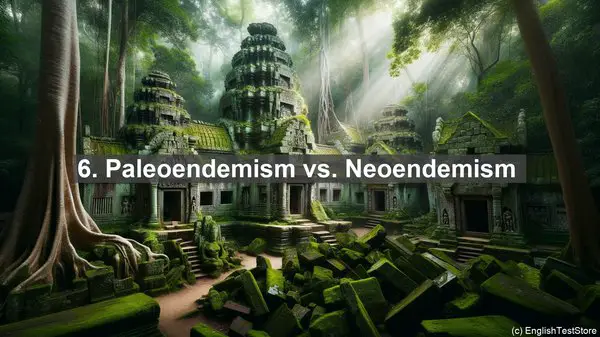Introduction
Welcome to today’s lesson on evolutionary biogeography. In this lesson, we’ll be discussing the top 10 commonly confused words in this field. Let’s dive in!

1. Endemic vs. Native
One of the most common confusions in biogeography is between the terms ‘endemic’ and ‘native.’ While both refer to species found in a specific region, ‘endemic’ means the species is exclusively found there, whereas ‘native’ indicates that the species originated in that region but may also be found elsewhere.

2. Dispersal vs. Migration
‘Dispersal’ and ‘migration’ are often used interchangeably, but they have distinct meanings. ‘Dispersal’ refers to the movement of individuals away from their birthplace, while ‘migration’ specifically denotes regular, seasonal movements of a population between different areas.
3. Vicariance vs. Dispersal
When it comes to explaining the distribution of species, ‘vicariance’ and ‘dispersal’ are two key concepts. ‘Vicariance’ refers to the separation of a population due to the formation of a physical barrier, such as a mountain range. ‘Dispersal,’ on the other hand, involves the movement of individuals to new areas without the presence of a physical barrier.
4. Sympatric vs. Allopatric
The terms ‘sympatric’ and ‘allopatric’ describe the geographic distribution of populations. ‘Sympatric’ means that two or more populations occupy the same area, while ‘allopatric’ indicates that populations are geographically separated and do not overlap.
5. Biogeography vs. Ecology
While related, ‘biogeography’ and ‘ecology’ are distinct fields. ‘Biogeography’ focuses on the spatial distribution of organisms and the processes that shape these patterns, whereas ‘ecology’ examines the interactions between organisms and their environment, regardless of their location.
6. Paleoendemism vs. Neoendemism
When discussing endemic species, it’s important to differentiate between ‘paleoendemism’ and ‘neoendemism.’ ‘Paleoendemism’ refers to species that have been restricted to a specific region for a long time, often due to historical factors. ‘Neoendemism,’ on the other hand, describes species that have recently become endemic to a region.
7. Biota vs. Biotic Community
While both terms refer to the living components of an ecosystem, ‘biota’ has a broader scope and includes all organisms, from microorganisms to plants and animals. ‘Biotic community,’ on the other hand, specifically refers to the interacting populations of different species within an ecosystem.
8. Speciation vs. Extinction
‘Speciation’ and ‘extinction’ are two fundamental processes in biogeography. ‘Speciation’ refers to the formation of new species, often as a result of geographic isolation. ‘Extinction,’ on the other hand, is the complete disappearance of a species from the Earth.
9. Biogeographic Realm vs. Biome
When discussing large-scale patterns of species distribution, ‘biogeographic realms’ and ‘biomes’ are often mentioned. ‘Biogeographic realms’ are regions with distinct faunal or floral assemblages, while ‘biomes’ are characterized by similar climatic conditions and vegetation types.
10. Endemism vs. Cosmopolitanism
The terms ‘endemism’ and ‘cosmopolitanism’ describe the distribution of species. ‘Endemism’ means that a species is restricted to a specific geographic region, while ‘cosmopolitanism’ indicates that a species has a worldwide distribution.
